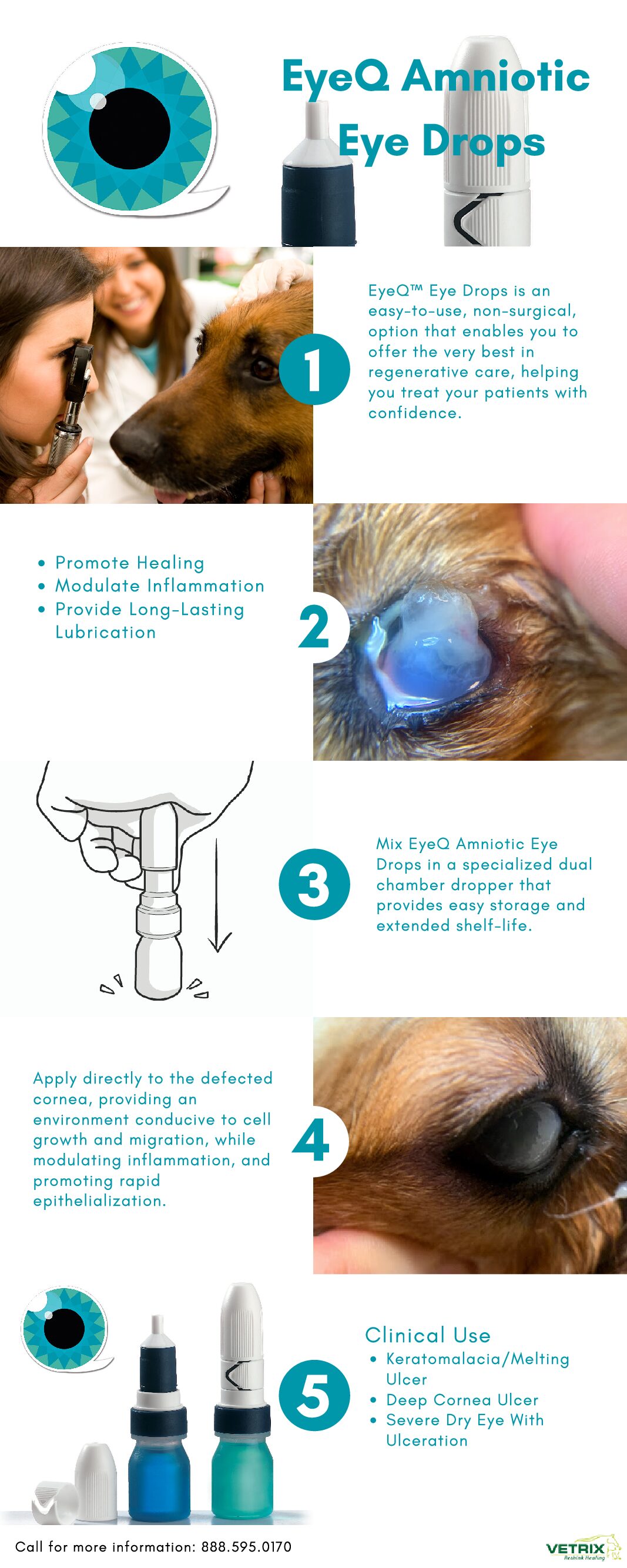Do You See Patients With Corneal Ulcers And Defects In Your Practice?
Confidently Delivering Superior Results
Using EyeQ Amniotic Eye Drops
Is Easy
If you treat corneal ulcers and other corneal defects in your practice, you need EyeQ Amniotic Eye Drops.
Have a question? Speak with a rep.
What Makes EyeQ Different?
Promote Healing
EyeQ’s innate concentrations of growth factors and immuno-privileged components promote rapid cell migration and epithelialization to the defect.
Modulate Inflammation
Corneal defects cause dramatic inflammation. With potent concentrations of anti-inflammatory properties, EyeQ Amniotic Eye Drops modulate inflammation which creates a superior healing environment.
Long Lasting Lubrication
High-molecular weighted Hyaluronic Acid (HC-HA) provides a viscous, long-lasting lubricant that prevents micro-injury caused by blinking.
Request Free Sample EyeQ Amniotic Eye Drop
Frequently Asked Questions
- EyeQ comes in a dual chamber bottle. Before the amnion and saline are mixed, EyeQ has an 18 month shelf life and can be kept at room temperature.
- After mixing it is recommended to keep EyeQ Drops in the refrigerator where they are good for up to 1 month.
- Some animals are sensitive to cold. It is recommended that EyeQ be warmed in hand or left out of the fridge until a comfortable temperature is reached.
- For Melting ulcers the standard treatment is 2-3 drops 3 times a day (TID). Treatment is usually 7-10 days, with a second bottle needed for some cases.
- For Dry Eye, TID is frequently recommended. The patient can then be moved to a maintenance dose of 1 or 2 times a day.
- EyeQ can be used as an adjunctive treatment. Where there are other medications being applied, EyeQ should be applied last.
Mixing the Amnion and Saline in the dual chamber bottle.
- To mix EyeQ you will remove the safety seal around the cap. Press downward firmly with the palm of your hand, holding the bottle with your other hand. You will feel a “pop” and see the amnion fall into the saline.
- After mixing the bottle will look cloudy. It can also have a plastic disc in the chamber which is normal. In some cases the disc does not fall into the chamber, that is okay as well. If the bottle does not look cloudy try pressing on the top again until the seal is broken.
References
- Baradaran-Rafii, A. (2018). The role of amniotic membrane extract eye drop (AMEED) in in-vivo cultivation of limbal stem cells. The Ocular Surface,16, 146-153.
- Cheng, A. (2016). Morselized Amniotic Membrane Tissue for Refractory Corneal Epithelial Defects in Cicatricial Ocular Surface Diseases. Translational Vision Science & Technology,5(3), 1-9.
- Kang, M. (2013). Effect of freeze dried bovine amniotic membrane extract on full thickness wound healing. Archives of Pharmacal Research,36, 472-478.
- Murri, M. (2018). Amniotic membrane extract and eye drops: A review of literature and clinical application. Clinical Ophthalmology,12, 1105-1112.
- Tighe, S. (2017). Topical Cryopreserved Amniotic Membrane and Umbilical Cord Eye Drops Promote Re-Epithelialization in a Murine Corneal Abrasion Model. Investigative Ophthalmology & Visual Science,58(3), 1586-1593.


